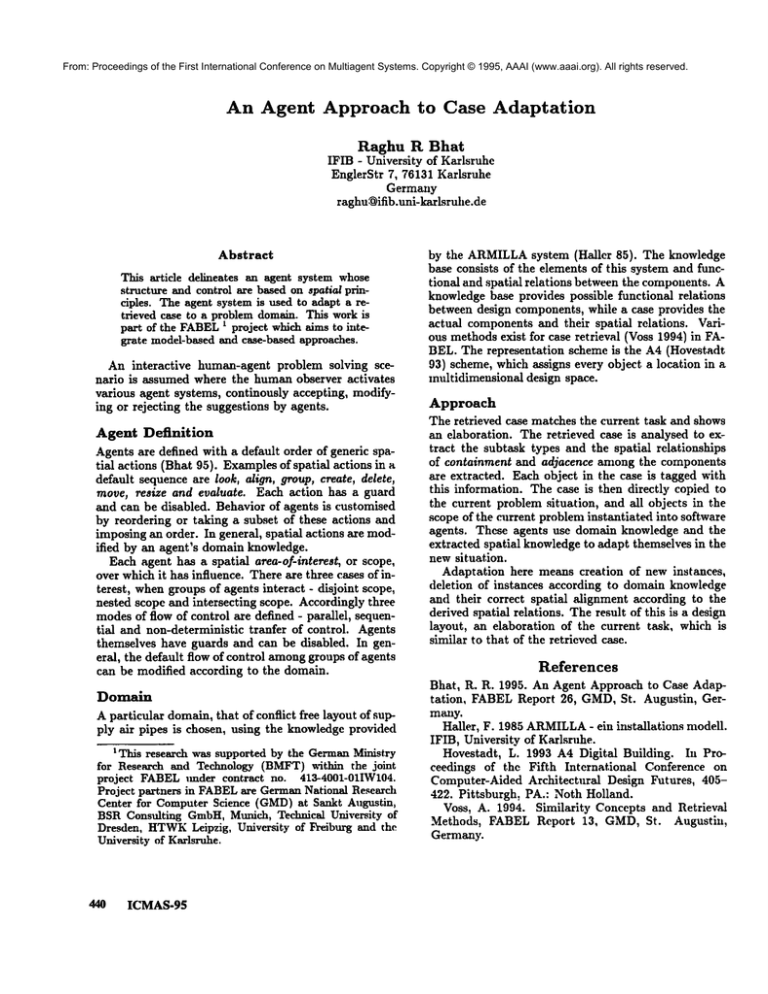
From: Proceedings of the First International Conference on Multiagent Systems. Copyright © 1995, AAAI (www.aaai.org). All rights reserved.
An Agent
Approach
to
Case
Adaptation
Raghu R Bhat
IFIB - University of Karlsruhe
EnglerStr 7, 76131 Karlsruhe
Germany
raghu @iflb.uni-karlsruhe.de
Abstract
This article delineates an agent system whose
structure and control are based on spatial principles. The agent system is used to adapt a retrieved case to a problem domain. This work is
part of the FABEL
i project which aims to integrate model-based and case-based approaches.
An interactive
human-agent problem solving scenario is assumed where the human observer activates
various agent systems, continously accepting, modifying or rejecting the suggestions by agents.
Agent Definition
Agents are defined with a default order of generic spatial actions (Bhat 95). Examplesof spatial actions in
default sequence are look, align, group, create, delete,
move, resize and evaluate. Each action has a guard
and can be disabled. Behavior of agents is customised
by reordering or taking a subset of these actions and
imposing an order. In general, spatial actions are modified by an agent’s domain knowledge.
Each agent has a spatial area-of-interest, or scope,
over which it has influence. There are three cases of interest, whengroups of agents interact - disjoint scope,
nested scope and intersecting scope. Accordingly three
modesof flow of control are defined - parallel, sequential and non-deterministic tranfer of control. Agents
themselves have guards and can be disabled. In general, the default flow of control amonggroups of agents
can be modified according to the domain.
Domain
A particular domain, that of conflict free layout of supply air pipes is chosen, using the knowledge provided
t This research was supported by the GermanMinistry
for Research and Technology (BMFT)within the joint
project FABEL1ruder contract no. 413-4001-01IW104.
Project partners in FABELare GermanNational Research
Center for Computer Science (GMD)at Sankt Augustin,
BSRConsulting GmbH,Munich, Technical University of
Dresden, HTWK
Leipzig, University of Fi-eiburg and the
University of Karlsruhe.
440
ICMAS-g5
by the ARMILLA
system (Hailer 85). The knowledge
base consists of the elements of this system and functional and spatial relations between the components. A
knowledge base provides possible functional relations
between design components, while a case provides the
actual components and their spatial relations. Various methods exist for case retrieval (Voss 1994] in FABEL. The representation scheme is the A4 (Hovestadt
93) scheme, which assigns every object a location in
multidimensional design space.
Approach
The retrieved case matches the current task and shows
an elaboration. The retrieved case is analysed to extract the subtask types and the spatial relationships
of containment and adjacence among the components
are extracted. Each object in the case is tagged with
this information. The case is then directly copied to
the current problem situation, and all objects in the
scope of the current problem instantiated into software
agents. These agents use domain knowledge and the
extracted spatial knowledgeto adapt themselves in the
new situation.
Adaptation here means creation of new instances,
deletion of instances according to domain knowledge
and their correct spatial alignment according to the
derived spatial relations. The result of this is a design
layout, an elaboration of the current task, which is
similar to that of the retrieved case.
References
Bhat, R. R. 1995. An Agent Approach to Case Adaptation, FABELReport 26, GMD,St. Augustin, Germa~y.
Haller, F. 1985 ARMILLA
- ein installations modell.
IFIB, University of Karlsruhe.
Hovestadt, L. 1993 A4 Digital Building. In Proceedings of the Fifth International
Conference on
Computer-Aided Architectural Design Futures, 405422. Pittsburgh. PA.: Noth Holland.
Voss, A. 1994. SimUarlty Concepts and Retrieval
Methods, FABEL Report 13, GMD, St. Augustin,
Germany.





